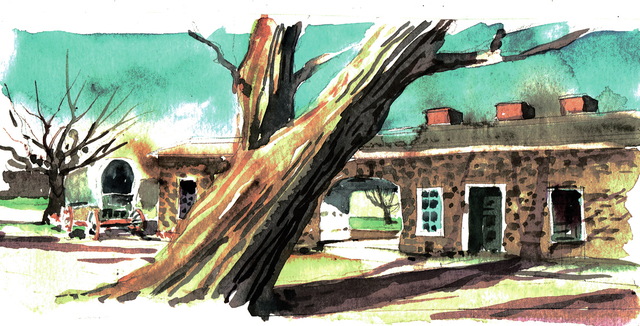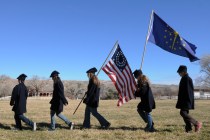Utah’s Cove Fort provides glimpse of pioneer times
Utah’s old Cove Fort welcomes passersby with an open door to the past. A stopping point for overland travelers since the 1850s, the historical site has been painstakingly restored as a monument to pioneer resolve and spirit.
Cove Fort, owned and maintained by the Church of Jesus Christ of Latter-day Saints, is open daily for guided tours free of charge.
Cove Fort is in south central Utah near the junction of Interstate 15 and Interstate 70, about 230 miles north of Las Vegas. Follow I-15 north into Utah on a scenic route past St. George, Cedar City and Beaver. Watch for the I-70 junction about 20 miles north of Beaver. Head east onto I-70 and turn off at exit 1. Drive north one mile to reach the restored fort and its attractive grounds.
When the West was being settled, a major overland trail ran from Salt Lake City to Southern California through territory now traversed by I-15. Situated between the pioneer communities of Beaver and Fillmore, little Cove Creek became a popular stopping point for travelers. A couple of families built shelters, planted gardens, orchards and grain fields, raised livestock and welcomed travelers. Because of intermittent Indian troubles, a crude wooden palisade was erected there for safety. Eventually, natural hardships and disease among the livestock forced the settlers to move.
After stopping at Cove Creek himself, Mormon leader Brigham Young decided it was a suitable site for a permanent wayside. In 1867, he asked Ira Hinckley, a pioneer who lived in Coalville, to establish such a facility. Leaving his family behind, Hinckley traveled to the abandoned fort. He located nearby sources of building materials and marked out a new defendable square structure measuring 100 feet on each side.
Calling on church members from established communities, Hinckley had workers and craftsmen building the new structure by April 1867. Crews quarried limestone and lava for foundations and walls. Others cut trees in the neighboring mountains, which were milled for timbers, lumber, doors, molding and furniture. Workers sheltered in the old palisade until construction was completed in November.
Set on limestone blocks, the black lava walls rose 18 feet high, tapering from 4 feet at the base to 2 feet at the top. Rifle ports in the walls commanded defensive positions. Large wooden doors at the east and west ends allowed wagons to be brought inside the compound. The north and south walls formed the back of 12 rooms arranged along either side, most linked by interior doors. Despite its defensive capabilities in a time of unrest, Cove Fort never had to be defended.
The wayside became the Hinckley family home. Orchards, gardens, poultry and dairy cattle provided amply for the family and for guests who arrived daily. As many as 75 guests were often fed and housed there. For 20 years, the busy site was headquarters for a church-owned ranch with a tithing herd tended by cowboys. It functioned as a telegraph station and a post office. The resident blacksmith created useful metal items, repaired wagons and coaches and shod horses.
The church eventually sold Cove Fort to another family that stayed there for nearly a century. In 1987, the Hinckley family repurchased the property and donated it to the church for restoration of the fort. Cove Fort was dedicated as a Mormon historical site in 1994. Church members on missions live on-site and serve as tour guides from early morning until sunset. Allow about an hour for the tour, which starts with an informative video in a small visitor center. Visitors may picnic in a park adjacent to a parking area.
During the annual observation of Cove Fort Days on Aug. 1 and 2, events will commemorate the fort’s 20th year as a Mormon historical site. Visitors can explore the past with living history presentations, period entertainment and music, stagecoach and wagon rides and free hot dogs and beverages.
Margo Bartlett Pesek’s Trip of the Week column appears on Sundays.






















